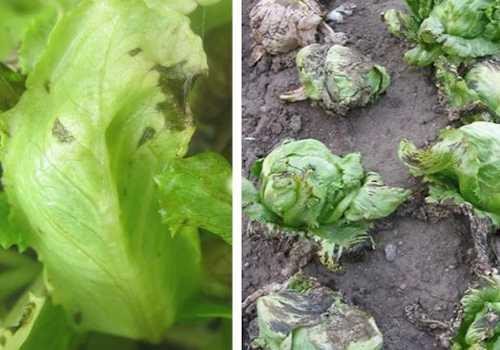By Maria Gorgo Gourovitch and Carolee Bull
Introduction
Lettuce bacterial leaf spot (BLS) was first described in 1918 by Ms. Nellie Brown, a researcher for the U.S. Department of Agriculture (Figure 1). She observed brown discoloration and spotting on lettuce leaves in a planting in South Carolina and subsequently isolated and characterized the causal bacterium. Her inoculation of healthy lettuce with the isolated bacterium and successful re-isolation of the same organism confirmed the pathogenicity of what would later be known as Xanthomonas hortorum pv. vitians (Xhv; previously X. campestris pv. vitians). Her extensive descriptions are still useful for identification of the pathogen today. The bacterium is rod shaped, gram negative, aerobic, and with polar flagella. Colonies on solid agar are pale yellow to cream in color and grow optimally at 26 to 28 degrees Celsius (Brown 1918).

Figure 1. Standing second from the left is Ms. Nellie Brown, the researcher who first described bacterial leaf spot of lettuce; she is pictured here among her fellow female colleagues at the USDA in the early twentieth century. Courtesy of the National Archives and Records Administration, Washington, D.C.
Symptoms and Epidemiology
The bacterium causes small, water-soaked spots that later coalesce into lesions on leaves (Figure 2). Old lesions can appear dark brown to black and may be dry and papery in texture (Koike and Bull 2017). Cool temperatures (50–75°F) and high moisture levels greatly exacerbate disease development where the pathogen is present in susceptible cultivars (Figure 3).
Outbreaks appear sporadically, and the pathogen is thought to be seedborne (Umesh, Koike, and Gilbertson 1996; Sahin and Miller 1997). Pathogen spread tends to occur through rain splash and sprinkler irrigation. Unanticipated outbreaks have historically caused up to 100 percent crop loss, and the last major outbreak in Florida in 2010 resulted in 50 percent yield loss. Postharvest damage due to secondary colonizers is also a significant concern (Koike and Bull 2017).
Lettuce is the most highly valued vegetable crop in the United States and production is highest in California, Arizona, Florida, and Ohio. Since the 1990s, the reemergence of the pathogen in the form of economically significant outbreaks in these areas has prompted increased research into effective disease management (Pernezny et al. 1995; Barak, Koike, and Gilbertson 2001; Bull, Goldman, and Hayes 2007). Significant and unexpected losses have been seen in the Mid-Atlantic region and the disease is present in several countries worldwide (Blanchard, Lot, and Maisonneuve 2006).

Figure 2. (left) Leaf sample showing necrotic spots that coalesce to form larger lesions. Courtesy of Dr. German Sandoya, University of Florida
Figure 3. (right) Necrosis of outer leaf tissue on lettuce heads. Courtesy of Dr. Carolee Bull, USDA
Disease Management
Disease prevention strategies include using certified, clean seed to prevent pathogen introduction, avoiding the use of sprinkler irrigation, removing crop debris and weeds that could harbor the pathogen, rotating slow-maturing crops (such as broccoli, cauliflower, and celery) to allow time for the pathogen to die off, and planting resistant cultivars. Upon first detection of the pathogen, copper hydroxide application can be used to manage the spread. The heirloom lettuce cultivars Little Gem, Pavane, and La Brillante have demonstrated strong resistance to Xhv strains isolated in California (Hayes et al. 2014) and the single plant introduction PI358001-1 has shown resistance to Xhv strains isolated in Florida (Wang et al. 2015). Other sources of resistance, including additional plant introductions and wild lettuce lines, are under investigation. Each bacterial strain belongs to one of at least three pathogenic races, and a different set of lettuce cultivars are resistant to each race (Bull, Trent, and Hayes 2016). This race-specific interaction is under investigation at Penn State, and a race-specific seed detection method is in development.
Source : psu.edu